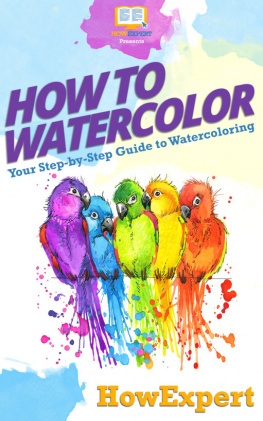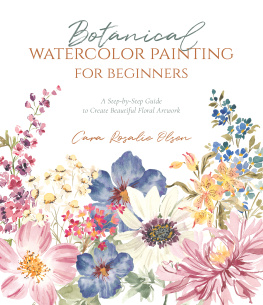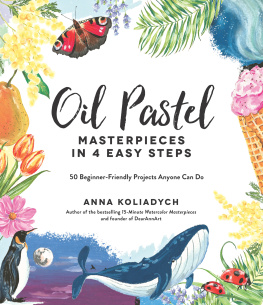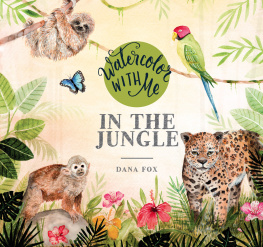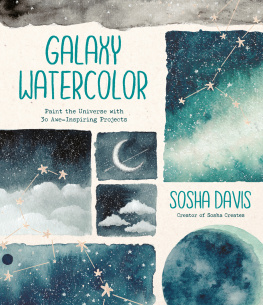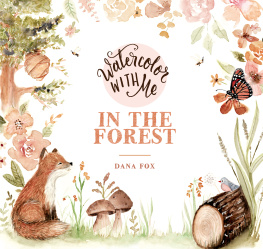Contents
Guide
15-MINUTE
Watercolor
MASTERPIECES
Create Frame-Worthy Art in
Just a Few Simple Steps
ANNA KOLIADYCH
The author and publisher have provided this e-book to you for your personal use only. You may not make this e-book publicly available in any way. Copyright infringement is against the law. If you believe the copy of this e-book you are reading infringes on the authors copyright, please notify the publisher at: http://us.macmillanusa.com/piracy.
TO MY FATHER, PAVEL KOLIADYCH, WHO TAUGHT ME HOW TO SMILE.

Copyright 2019 Anna Koliadych
First published in 2019 by
Page Street Publishing Co.
27 Congress Street, Suite 105
Salem, MA 01970
www.pagestreetpublishing.com
All rights reserved. No part of this book may be reproduced or used, in any form or by any means, electronic or mechanical, without prior permission in writing from the publisher.
eISBN 978-1-62414-881-1
Our eBooks may be purchased in bulk for promotional, educational, or business use. Please contact the Macmillan Corporate and Premium Sales Department at 1-800-221-7945, extension. 5442, or by e-mail at .
Library of Congress Control Number: 2019940364
Cover and book design by Anna Koliadych
Cover image Anna Koliadych
Hello, my name is Anna! I am an illustrator and watercolor artist. I can truly say that painting is my passion in life.
I always say that watercolor is a magical and unique medium. If you begin this journey with this wonderful medium, you will see how fun it can be.
The key to painting with watercolors is practice and consistency. Watercolor can sometimes require patience, but even for a beginner, its easy to get the hang of it. Im a real example of this. Though I did some painting as a child, I started to use watercolors professionally only four years ago. It is a great way to do quick paintings and sketches. Its full of freedom in regard to color and lines, and you can also create nice effects and textures.
This book focuses on painting quickly with watercolors. I call this 15-minute painting because each project will take you only 15 minutes. Since I started teaching watercolor, Ive noticed that my students usually cant practice daily, as most of them are too busy with work, family or housework. What to do? If you are busy but still want to paint, then the solution is quick painting sessions. Here you will find different projects, lessons and exercises with one aimpracticing and learning watercolor in just 15 minutes a day. A thousand people on Instagram have already practiced my methods and started to paint with watercolors daily, opening their creativity and improving their skills. I hope you will also find 15-minute painting sessions useful and allow yourself to unleash your creative spirit.
HOW TO WORK WITH THIS BOOK
This book is very easy to work with. The first part includes the basics that you need to know to start painting with watercolors. Ive tried to keep all explanations clear and simpleonly important information, no fluff at all. The second part is filled with ways to practice your skillsfifty original projects that take just 15 minutes. I divided them all into chapters that each focus on a different subject, and in each chapter, the projects are sorted from the simplest to the most complicated.
Each project contains a step-by-step lesson and detailed description. Ive also included color theory and technique chapters.
I recommend you choose a project each day and vary the lessons according to your mood. Its better to go from simple tasks to more difficult ones. Try to pick projects by following your heart.
Believe in yourself; enjoy the process; have fun; experiment with colors, shapes and compositions; and feel and listen to yourself. Most importantly, love what you do!
With love,
Anna

Thank you for buying this
Page Street Publishing Co. ebook.
To receive special offers, bonus content,
and info on new releases and other great reads,
sign up for our newsletters.

Or visit us online at
us.macmillan.com/newslettersignup
If you are new to watercolor, the most difficult thing for you may be getting the balance between water and color pigment right to make different consistencies of paint.
With each color you can get three (or even more) different shades: transparent, medium and very rich. The whole point is that the more water you add to the paint, the more transparent the shade will be on paper.
I will show you an exercise that will help you understand how it works.
Before we start, lets prepare your watercolors. If your watercolor set has pans, you need to add a few drops of water in each of them before you start to paint.
For watercolors in tubes, squeeze a little bit of paint on a palette or a plate, then add a few drops of water.
To start, well work with one color. Add a little water to the color you chooseenough for the brush to move easily across the surface of the palette. The brush should not be dry. NOTE: For all of the techniques mentioned here, with the exception of the dry brush technique, your brush should always be wet before adding paint to the brush.
Now paint a shape (for the example, I chose a circle). You should get a very rich and deep color. This is the first shade. For the next shade, add some more water to the paint on the palette or into the pans and paint another shape. You should get a more transparent shade, and the consistency of the paint should be thinner than in the previous stage. Then add even more water to the paint on the palette and paint the shape again. Keep adding water and painting shapes until you reach a shape with a transparent tint.
Youll have to practice to understand how much water you need to add to a paint to make very rich, medium and transparent consistencies. With time, you will get a feel for when youve added enough water and obtained your desired consistency.

Figure 1

Figure 2
Brush strokes may seem difficult at first, but taking some time to practice them will save you a lot of time in the future. So, prepare your brushes, and lets figure out how to use them properly.
I remember how scary using the brushes seemed when I started painting with watercolors. I thought that there was nothing more complicated. But with lots of practice, I gradually mastered working with all kinds of brushes, and now I love using all types.

![Anna Koliadych [Анна Колядыч] 15-Minute Watercolor Masterpieces: Create Frame-Worthy Art in Just a Few Simple Steps](/uploads/posts/book/305450/thumbs/anna-koliadych-a-k.jpg)

